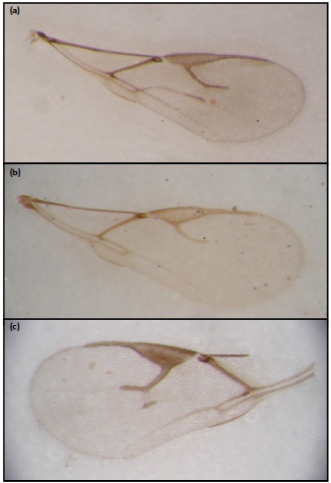eISSN: 2576-4462


Short Communication Volume 5 Issue 3
1Student in the Department of Agronomy, Life Sciences Division, Campus Irapuato-Salamanca, University of Guanajuato, Mexico
2Teacher. Department of Agronomy, Life Sciences Division, Campus Irapuato-Salamanca, University of Guanajuato, Mexico
Correspondence: Manuel Darío Salas-Araiza, Teacher. Department of Agronomy, Life Sciences Division, Campus Irapuato-Salamanca, University of Guanajuato, Mexico
Received: April 08, 2021 | Published: May 3, 2021
Citation: Arredondo-Negrete V, Benitez-Corrales CF, Salas-Araiza MD, et al. Parasitoids of aphids (Hemiptera: Aphididae) in Irapuato, Guanajuato, Mexico. Horticult Int J. 2021;5(3):100-101. DOI: 10.15406/hij.2021.05.00211
Knowing the parasitoids that attack aphids is important as tools for integrated management. The present work was carried out in Irapuato, Guanajuato, Mexico. Hordeum vulgare, Brassica oleracea var. italica, Ficus_ benjamina and Amaranthus spp. Diaretiella rapae (Hymenoptera: Apidiidae) parasitized Brevicoryne brassicae in 60.8% and Myzus persicae in 73%; Schizaphis graminum was parasitized by Aphidius spp in 48% and Lysiphlebus spp with 26.6%, Aphis spp in amaranth was parasitized by Aphidius spp in 73.3%. It is suggested to establish strategies to conserve this parasitoid due to its ability to parasitize aphids.
Keywords: aphids, parasitoids, barley, broccoli
Aphids reproduce in large numbers; on average a female produces between 50 and 100 offspring per cycle and these new individuals only take a few weeks to mature and reproduce; they are important vectors of viruses.1
Hymenopterans of the Aphidiidae family are specific parasitoids of aphids and play an important role in biological control, which is why they have great potential in integrated aphid management programs.2
The adult female of these parasitoids inserts one or more eggs per aphid, but only one survives. Between 5 to 7 days after being parasitized, the aphid acquires a globose and leathery appearance, the complete cycle of the parasitoid has an average duration of 10-15 days. Once it has reached the adult stage, the wasp makes a hole in the abdomen through which it emerges.3
Knowing the parasitoid species of pest insects and their incidence will help in the establishment of integrated management programs; therefore, the objective of the work was to identify the aphid parasitoid species and the percentage of each of the species in the parasitized individuals.
The field work was carried out in March 2019 in Irapuato, Guanajuato. Mexico. Random leaf samples were taken from the following species: barley (Hordeum vulgare), broccoli (Brassica oleracea var.italica), ficus (Ficusbenjamina) and amaranth (Amaranthus spp). Leaf samples were kept in the brood chamber (27°C; 30% RH; 12:12 photoperiod) in the Entomology laboratory of the Department of Agronomy of the University of Guanajuato, in Irapuato, Mexico, to await the emergence of the parasitoids.
The identification of aphids was based on the keys of Blackman and Eastop1 and of the parasitoids in Kavallieratos et al.4
The identified parasitoid species emerged from aphids were: Aphidius spp, Diaretiella rapae MacIntoch, and Lysiphleblus spp (Figure 1).

Figure 1 Aphid parasites identified. a) Aphidius spp; b) Diaretiella rapae M´Intosh; c) Lysiphlebus spp.
The aphidsBrevicoryne brassicae (L.) andMyzus persicae (Sulzer) were preferentially parasitized by D. rapae in 60.8 and 73% respectively in broccoli; in this regard Salas-Araiza et al.5 indicated that the parasitism of D. rapae in B. brassicae reached up to 35.7% in January, but they did not report the presence of parasitism in M. persicae; D. rapae is a specialist parasitoid of B. brassicae and presents a high degree of specificity for the host and its habitat, it uses the smell of the plant to locate the host, butAphidius nigripes Ashmead is a polyphagous parasitoid that does not present a response, the smell of the plant.6
The green grass aphidSchizaphis graminum (Rondani) was parasitized by Aphidius spp up to 48%, Salas-Araiza et al.7 pointed out the potential of Aphidius spp as a parasitoid of aphids; observed that the yellow sugarcane aphidMelanaphis sacchari (Zehntner) was parasitized by Aphidius spp in 31% and Praon in 29%. This result demonstrates the benefits of conserving and protecting wasps of the genus Aphidius due to their versatility in parasitizing different species of aphids and their ability to parasitize.
In 2011, Salas-Araiza et al.2 indicated that there was no parasitism in Greenidea ficicola Takahashi and that the main biological control agent was predators; in this investigation although the parasitoids were not obtained if parasitized aphids were observed in 20%. The populations of G. ficicola do not affect the tree but it does produce a large quantity of honeydew, due to its evergreen characteristic, this tree species serves as a refuge for various species of predators and parasitoids. This aphid is of Asian origin, thermophilic and anholocyclic that is dispersing to different regions of the world, thanks to climate change Bella et al.8 and world trade,9 which possibly explains the low presence of associated parasitoids.
Lysiphlebus is a genus of importance in the biological control of S. graminum, in wheat it can maintain populations below the economic threshold of damage and in sorghum it parasitizes M. sacchari,10 in this work it parasitized in 26.6%, but Aphidius spp prevailed with 73.3% over Aphis spp in amaranth. The aphid Aphis is a polyphagous genus of Aphididae, the observed population was very abundant and produced a large quantity of honeydew, seriously affecting the plant.
The most abundant parasitoids were Aphidius spp with 73% in the aphid Aphis spp and Diaretiella rapae in Myzus persicae with the same percentage.
In barley Schizaphis graminum was parasitized by Aphidius spp in 48%.
It is suggested to conserve and increase the populations of Aphidius spp due to its abundance and capacity for parasitism shown in this research, through conservation shelters free of insecticide application and possibly its massive reproduction.
None.
None.
The authors have no conflict of interest for this research.

©2021 Arredondo-Negrete, et al. This is an open access article distributed under the terms of the, which permits unrestricted use, distribution, and build upon your work non-commercially.